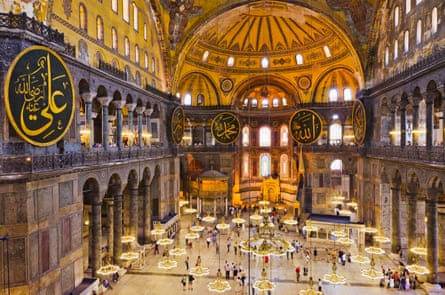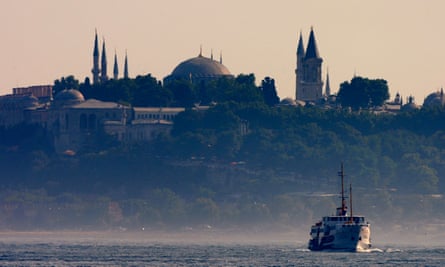For 900 years, Muslim caliphs and sultans took it upon themselves to fulfil the Prophet Mohammed’s prophecy that a great conqueror would one day bring the holy city of Constantinople into Islam’s embrace.
In 1453, when Ottoman Sultan Mehmed II finally succeeded in breaking through the Byzantine city’s walls, he immediately made his way to the largest cathedral in Christendom. As sunlight glittered off gold mosaics of the Virgin Mary and incense smoke drifted up into the building’s vast dome, he fell on his knees and prayed.
The young conqueror’s decision to convert the Hagia Sophia (Holy Wisdom) in Greek, now known as Ayasofya in Turkish – into an imperial mosque was a powerful symbolic act, as was a move nearly one hundred years ago by the Turkish Republic’s secular founder, Mustafa Kemal Atatürk, to turn the place of worship into a museum. Today, the Ayasofya is still at the heart of a potent ideological battle.
Converting Istanbul’s crowning architectural treasure back into a mosque has been a cause close to the hearts of Turkish nationalists and Islamists for decades. It has been opposed with equal fervour by Greece and Turkish liberals who argue the move would disrespect the history of the country’s Christian minority and erode the Republic’s secular character.

While sympathetic to the idea, President Recep Tayyip Erdoğan himself stayed out of the public debate until last year. Since then, however, he has expressed full-throated support for the move, partly as an effort to distract from policy failures and shore up waning popular support among his Justice and Development party (AKP)’s conservative voter base.
On 2 July, Turkey’s Council of State will make a final decision on a legal case regarding the Ayasofya’s status. It is expected to rule in favour of fully restoring its Muslim heritage.
Even after 18 years in charge, such a move will be the Turkish leader’s boldest message yet to detractors both at home and abroad that his country has decisively turned away from its alliances with the west in pursuit of a greater Neo-Ottoman destiny.
Last month, when asked in a televised interview to respond to Greek anger over the potential decision, Erdoğan deployed a staple of his rhetorical toolbox, framing the issue as a matter of national sovereignty.
“They dare telling us not to transform Ayasofya into a mosque. Are you ruling Turkey, or are we?” he asked.
Lawsuits to change the museum’s status have been brought in the past and failed, but this time there are new legal precedents to suggest the ruling will go in Erdoğan’s favour.
In 2019, the same court ruled that the Chora, another Byzantine church in Istanbul which like the Ayasofya became a mosque and then a museum, should have its museum status revoked. Buildings with similar histories in Iznik and Trabzon were turned back into functioning mosques in 2011 and 2013 respectively.
There have been several signs that the Ayasofya is next: in recent years the building has been used for recitals of the conquest verses of the Quran ahead of Turkey’s military incursions over the border in Syria. Under the AKP government, celebrations of Istanbul “conquest day” – the anniversary of Mehmed II’s victory over the Byzantines – have grown more elaborate each year, again accompanied by religious readings in the Ayasofya blasted out over the city on loudspeakers.
“The Ayasofya’s reconversion into a mosque is not only a matter of popular mobilisation. Stimulating a war rhetoric about the need for protecting national sovereignty, it should also be thought about in the context of the rising tension with Greece in the Eastern Mediterranean,” said Sinem Adar, an associate at the Center for Applied Turkey Studies at the German Institute for International and Security Affairs.
“A positive ruling would also strengthen the already existing perception within Europe that Turkey acts unilaterally and does not abide by international norms and institutions.”
In the past year, relations between Turkey and Greece have soured once again over the fate of divided Cyprus, refugee flows and contested oil and gas drilling rights in the Mediterranean.

Last week the Greek ministry of culture appealed to Unesco over Turkey’s impending decision, claiming that converting the Ayasofya would violate conventions Ankara has signed regarding the building’s international status. Greek displeasure, however, is exactly what a positive ruling is intended to provoke.
Despite the fact that the ruling on the Ayasofya’s future has not yet been made, Erdoğan has reportedly already instructed his advisory council to make plans to hold the first prayers in the building on 15 July, the fourth anniversary of the failed coup against him.
As Turkey grows ever bolder on the world stage, most notably turning the tide of the war in Libya, the prospect of verses of conquest ringing out in an Ayasofya restored to Islamic glory is a revealing insight into what Erdoğan hopes the country’s future – and his own legacy – will hold.
The last time the president spoke in the building was 29 May, the anniversary of Mehmed II’s victory, known in Turkish as Fatih Sultan Mehmet, “the conqueror”.
“We will leave behind a Turkey befitting of our ancestor Fatih,” he said.
